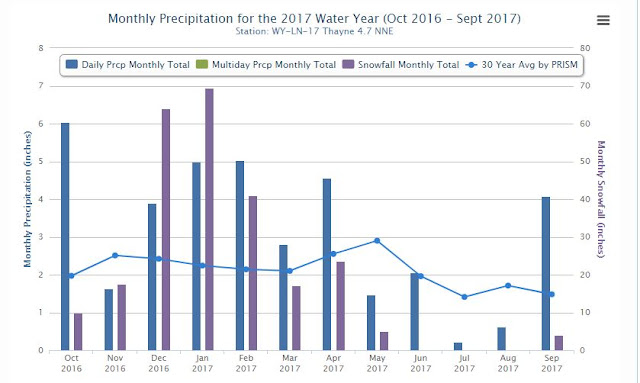There are many thousands of CoCoRaHS observers across the United States.
 |
| Plot of CoCoRaHS observations on Oct 27 2017 |
 |
| Active CoCoRaHS observers in Wyoming |
What is CoCoRaHS?
CoCoRaHS is an acronym for the Community Collaborative Rain, Hail and Snow Network. CoCoRaHS is a unique, non-profit, community-based network of volunteers of all ages and backgrounds working together to measure and map precipitation (rain, hail and snow). By using low-cost measurement tools, stressing training and education, and utilizing an interactive Web-site, our aim is to provide the highest quality data for natural resource, education and research applications. We are now in all fifty states.
Download the updated "CoCoRaHS Brochure" as a PDF (12.4 MB)
CoCoRaHS Wanted Flyer PDF (164 KB)
In northern Lincoln County there are currently about 6 observers that report their precipitation and snow depths every day. They include
Two in Star Valley Ranch, one each near Thayne, Etna, Afton and Smoot.. While these reports help give some idea of distribution of precipitation across Star Valley, more observations are needed throughout the area to provide a better analysis of rain/snow in the Valley. Anyone familiar with Star Valley's weather knows there can be big differences over short distances when storms cross the area.
Download the updated "CoCoRaHS Brochure" as a PDF (12.4 MB)
CoCoRaHS Wanted Flyer PDF (164 KB)
In northern Lincoln County there are currently about 6 observers that report their precipitation and snow depths every day. They include
Two in Star Valley Ranch, one each near Thayne, Etna, Afton and Smoot.. While these reports help give some idea of distribution of precipitation across Star Valley, more observations are needed throughout the area to provide a better analysis of rain/snow in the Valley. Anyone familiar with Star Valley's weather knows there can be big differences over short distances when storms cross the area.
Where did the CoCoRaHS Network originate?
The network originated in the Colorado Climate Center at Colorado State University in 1998, thanks in part to the Fort Collins flood a year prior. In the years since, CoCoRaHS now includes thousands of volunteers nationwide.
Who can participate?
This is a community project. Everyone can help, young, old, and in-between. The only requirements are an enthusiasm for watching and reporting weather conditions and a desire to learn more about how weather can affect and impact our lives.
What will our volunteer observers be doing?
Each time a rain, hail or snow storm crosses your area, volunteers take measurements of precipitation from as many locations as possible. These precipitation reports are then recorded on our Web site www.cocorahs.org. The data are then displayed and organized for many of our end users to analyze and apply to daily situations ranging from water resource analysis and severe storm warnings to neighbors comparing how much rain fell in their backyards.
Who uses CoCoRaHS?
 |
| Water Year 2017 CoCoRaHS plot of Observations at Star Valley Ranch |
Who uses CoCoRaHS?
CoCoRaHS is used by a wide variety of organizations and individuals. The National Weather Service, other meteorologists, hydrologists, emergency managers, city utilities (water supply, water conservation, storm water), insurance adjusters, USDA, engineers, mosquito control, ranchers and farmers, outdoor & recreation interests, teachers, students, and neighbors in the community are just some examples of those who visit our Web site and use our data.
What do we hope to accomplish?
CoCoRaHS has several goals (as stated in our mission statement). 1) provide accurate high-quality precipitation data for our many end users on a timely basis; 2) increasing the density of precipitation data available throughout the country by encouraging volunteer weather observing; 3) encouraging citizens to have fun participating in meteorological science and heightening their awareness about weather; 4) providing enrichment activities in water and weather resources for teachers, educators and the community at large to name a few.
Who is sponsoring this network?
The National Oceanic and Atmospheric Administration (NOAA) and the National Science Foundation (NSF) are major sponsors of CoCoRaHS. Other organizations have contributed either financially, and/or with supplies and equipment.
What benefits are there in volunteering?
One of the neat things about participating in this network is coming away with the feeling that you have made an important contribution that helps others. By providing your daily observation, you help to fill in a piece of the weather puzzle that affects many across your area in one way or another. You also will have the chance to make some new friends as you do something important and learn some new things along the way. In some areas, activities are organized for network participants including training sessions, field trips, special speakers, picnics, pot-luck dinners, and photography contests just to name a few.
How can I sign up?
Just click here to sign up as a CoCoRaHS Volunteer Observer or download a .pdf version of our application and return it as soon as possible.



















